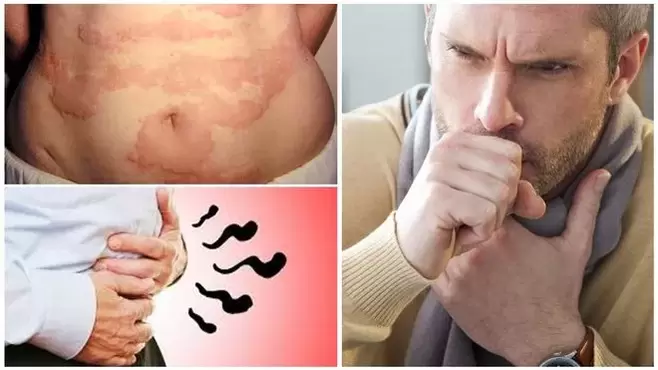In the last century, personal hygiene has improved significantly, but the problem of worms is still relevant not only for rural residents, but also for urban residents. Statistics clearly show the high risk of helminth infestations: one in three people on the planet suffers from helminthiasis. However, the disease does not always manifest itself clearly, and in some cases, patients are unable to correctly interpret the symptoms without taking any action and remain in the dark for a long time. Questions about how to understand the presence of worms arise with helminthiasis and other pathologies with similar symptoms.

Worms are a broad group of parasitic worms whose main features of existence in the human body are similar. Doctors believe that every person has been exposed to helminthiasis at least once in his life. In addition, the presence of helminths in the body can lead to the development of other diseases, sometimes very dangerous, so the diagnosis of this disease is very important.
Mechanisms of infection
Infection with worms occurs in four main ways:
- Water, soil or sand. Soil and water create ideal conditions for the storage of parasitic eggs. A person swimming in open water is always at risk of swallowing eggs and later becoming an adult. Not infrequently, humans are also at risk of infection by ingesting earth particles. Some types of parasites can enter the body directly through the skin.
- Food.The skins of unwashed or improperly cooked fruits and vegetables may contain worm eggs. Raw or lightly processed meat, dried fish, dairy products, etc. consumption is not associated with the least risk.
- Contact the patient. Direct contact can occur with both a sick person and an infected animal. Joint activity, living in a common area, close communication helps parasites to enter the intestines quickly and further develop it.
- bites.Worms can be transmitted by insect bites. This is one of the rarest ways of infection in temperate latitudes, but is sometimes the cause of the disease. This way is more common in hot countries, it should be remembered when going on vacation to hot lands.
Symptoms
For those who want to know how to tell if you have worms, you need to understand the principles of identifying symptoms. Any signs of helminthiasis appear not immediately after infection, but only when the parasite stops migrating from the gastrointestinal tract and begins to develop into an adult.
Some of the symptoms are related to the worm's lifelong absorption of toxins. All waste enters the lumen of the intestine, from where it is absorbed into the blood and carried to all organs. There are usually more symptoms, and they become more severe in the case of multiple infections when the number of worms increases significantly. In people with immunosuppression or other chronic diseases, symptoms worsen in a relatively short period of time.

All signs are divided into two major groups: overt and covert. Those that are obvious can be assessed independently at home, and those that are hidden can only be identified in an outpatient setting with the help of appointments for certain tests and examinations.
Openly
What is obvious includes symptoms that may indicate the presence of worms in the body. Their presence does not cause very obvious symptoms, such as the development of viruses. Parasites are directed to life inside the body, so the deterioration of the condition of the infected host will be life-threatening. For this reason, the symptoms do not require emergency care.
You can suspect or understand the presence of helminthic infestation with the following symptoms:
- Gradual weight loss for no apparent reason, lasting several months, sometimes several years in a row. The rate of weight loss is not catastrophic, in most cases it is 2-5% per month. In people with weakened immunity, this figure can reach 10% with a high intensity of infection.
- Disorders of the gastrointestinal tract. Some worms can block the bile ducts or intestinal lumen, causing persistent constipation. With high intensity of toxin release, on the contrary, recurrent diarrhea can occur. Inflammation of the walls of the upper part of the small intestine is often accompanied by an increase in flatulence and gas, and swelling is possible.
- Severe pain in the joints and muscles. Often such manifestations are associated with the development of osteoarthritis, but in the case of helminths, it leads to the migration of parasites. In addition, such pain may be due to the effects of toxins on joints and muscle tissue.
- Itching near the anus. This phenomenon is due to the fact that many species of parasitic worms crawl out of the lumen of the rectum to reproduce and lay eggs. This causes intense itching, which tends to worsen in the evening and at night.
- allergic manifestations. It often occurs in response to the appearance of many toxins in the blood or due to damage to the intestinal mucosa, which leads to an increase in the immune system and an allergic reaction.
- Pulmonary manifestations. It is possible in a wide range, from a persistent cough to pneumonia. It is characteristic of intensive ascariasis, which occurs not less than three months after infection.
- High temperature. Such a manifestation can have different intensities. Most of the time, temperatures as low as about 37 ° C persist day and night, but rarely fever can be observed.

Secret
Hidden symptoms can only be detected by a doctor who will adequately assess the clinical picture and understand that the worms may be the probable cause. Preventive measures for the diagnosis of helminthiasis are:
- Analysis of feces for worms. It must be submitted in two stages, so experts do not consider the results of one analysis to be reliable. This is due to the periodicity of reproduction, so it is not always possible to tell from a stool analysis that a patient is suffering from helminths.
- Clinical blood test. High levels of eosinophils indicate the possibility of parasites in the body. Often such a hypothesis arises after tests during the treatment or diagnosis of other diseases.
- Antibody analysis. It is currently one of the most reliable diagnostic methods to help a person determine if they have worms. Although it is more expensive than similar drugs, doctors are increasingly choosing to prescribe it due to its high information content and reliability.

Antiparasitic drugs or laxatives should not be taken before any clinical testing for parasites, as this complicates the diagnosis.
Symptoms in a child
The presence of worms in children is diagnosed more often than in adults. Poor hygiene, close contact with pets or stray animals contribute to the full development of the immune system. A growing organism usually reacts more sharply to the presence of parasites, and the consequences can be more global than in adults. But it is not easy to understand that a child has worms. Symptoms may be the same as in adults, but in most cases are more severe.
In most cases, the symptoms of helminthic infestation in children are:
- Rapid weight loss. With a working image, such a manifestation can lead to a delay in physical development;
- Deterioration of hair and nails. Occurs due to long-term deficiency of nutrients and vitamins, resulting from impaired absorption of digested food in the intestine.
- Sleep disorders. The pathology can cause the child to wake up more often at night, cry, turn around and talk in his sleep.
- Irritation. Nervous system intoxication and poor health can affect a child's emotional state, leading to increased anxiety, whimsy, tearfulness, and so on.
- Constant desire to scratch the anus. Children do not control external manifestations, so this symptom often helps to understand the cause of diseases and physical changes.

Some parents tend to give their children a broad-spectrum antiparasitic medication for prophylaxis, but experts do not recommend doing so because most of these medications are very difficult to tolerate. It is better to first understand whether the child is infected and what treatment is needed, because the therapy of different types of worms is significantly different and is not always effective for helminths of other groups.






































